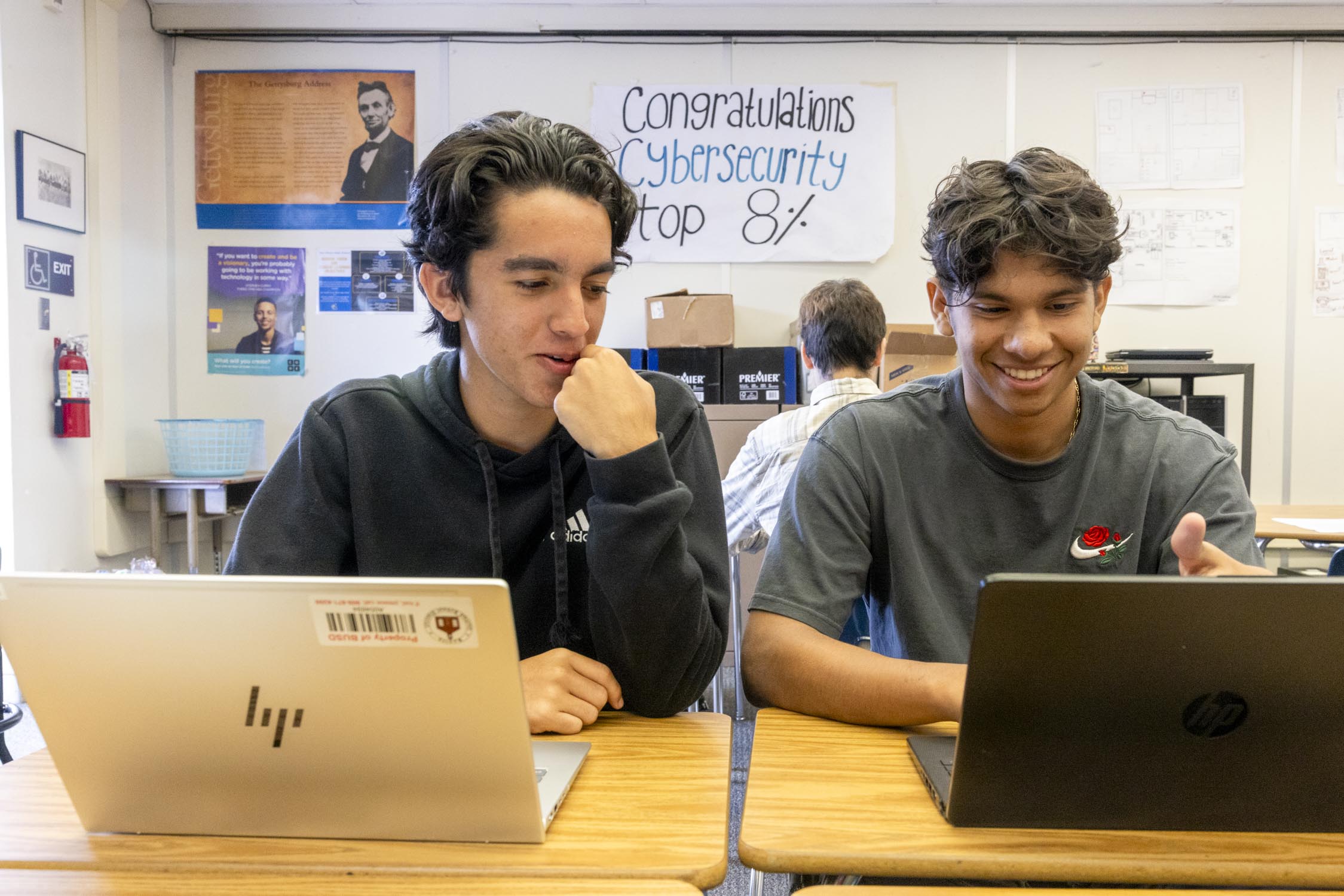Bonita Unified School District
Bonita Unified Cybersecurity Students Learn What It Takes to Become Ethical Hackers
SAN DIMAS/LA VERNE – In an age of rapid technological advances, as the risk of falling victim to a cyberattack continues to rise to unprecedented levels, San Dimas High School is training a new generation of cyber defenders and tech troubleshooters to become ethical hackers through its Information Technology (IT) and Cybersecurity class.
The class, led by San Dimas High computer science teacher Leslie Leaming, is a hands-on learning experience where students rebuild and repair devices, design games, develop websites, and attempt to solve real-world cybersecurity challenges. The comprehensive course gives students an opportunity to explore lucrative careers in the IT and cybersecurity fields.
Each year, the class participates in Carnegie Mellon University’s annual picoCTF “Capture the Flag” competition, which challenges students’ cyber-sleuth skills as they hunt down corrupted coding and suspect hyperlinks to secure digital flags, covering a range of cybersecurity domains such as general skills, cryptography, web exploitation, forensics, and more.
Leaming’s cybersecurity class did extraordinarily well this year, led by the team of San Dimas High Class of 2025 graduates Daniel Trujillo and Brandon Guzman, who finished in the top 8% of competitors nationwide. Leaming’s second-place team finished in the top 12% and the third-place team finished in the top 18%. More than 1,800 teams across the country participate in the picoCTF competition.
“The competition results are a testament to the creativity and ingenuity of our IT students,” Leaming said. “We all know how easy it is to get hacked, and the problem is even bigger for young adults. Learning cybersecurity not only allows them to protect themselves and their friends and family from attacks, but with nearly 500,000 job openings in the U.S., this is a rapidly expanding industry that is essential to the security of our lives.”
Guzman and Trujillo both have a knack for coding and solving puzzles, qualities that make them ideal for cybersecurity training. Using digital forensic tools such as Kali Linux, the pair dove into the competition, searching websites for weaknesses in HTML and Javascript code, then working to repair the code.
“This class is unlike any other class I’ve ever taken,” Guzman said. “I’m a logical thinker and like how there is something different to do every day, a new project. You are practicing, using tools, learning fundamentals. Mrs. Leaming is an amazing teacher. She is always there to help you and never runs out of projects we can work on.”
Guzman plans to attend Cal Poly Pomona in the fall and study computer science. Trujillo is considering enrolling at Mt. SAC or enlisting in the U.S. Armed Forces, with a goal of continuing his study of cybersecurity.
“I can really see myself doing this. Cybersecurity is a puzzle where you’re trying to find out what’s wrong and then figure out what pieces to use to fix it,” Trujillo said. “I enjoy learning about practices like cryptography and looking for the errors in code. It’s great when you find the solutions and receive the digital badges.”
The picoCTF competition is held over the course of two weeks, allowing Leaming’s students to work at their own pace, in teams or individually, in class or at home. The class practices for months, using tools provided on the picoCTF website.
Beginning in the 2025-26 school year, IT/Cybersecurity will transform into a two-year pathway, with an advanced IT/Cybersecurity class to be added to the curriculum. The new class will expand its focus to include learning the secret language of hackers, exploring a simulated cyber-crime scene, the psychology of hacking, and how to ensure that ubiquitous smart devices and high-tech systems are safe and secure.
“Technology makes life easier for so many people, but also gives cybercriminals golden opportunities to hack your personal information and steal your identity,” Leaming said. “To win this war we need students who understand the ethics of modern-day tech, and who are eager to make ethical hacking a career choice. The IT/Cybersecurity pathway at San Dimas High will allow our students to learn the rules and make the right choices.”
PHOTO CAPTION:
BUSD_SDCYBERSECURITY: San Dimas High Class of 2025 graduates Daniel Trujillo, left, and Brandon Guzman, right, finished in the top 8% of competitors during a recent national “Capture the Flag” cyber-competition sponsored by Carnegie Mellon University.

Bonita Unified Cybersecurity Students Learn What It Takes to Become Ethical Hackers
Bonita Unified School District
- Image Title
- BUSD_SDCYBERSECURITY
- Image Caption
- BUSD_SDCYBERSECURITY: San Dimas High Class of 2025 graduates Daniel Trujillo, left, and Brandon Guzman, right, finished in the top 8% of competitors during a recent national “Capture the Flag” cyber-competition sponsored by Carnegie Mellon University.
Right-click on the image to save
